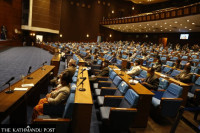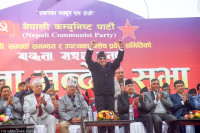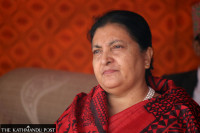Politics
Communist unity top on agenda as Chinese flock to Nepal
Watchers say they are trying to lay ground for a Nepal that is no threat to China. This includes tackling other powers.
Anil Giri
Barely a week after a delegation from Yunnan Province of China left the country, another Chinese contingent is currently in Lumbini.
Shi Yugang, deputy secretary of the Standing Committee of the Communist Party of China Yunnan Provincial Committee, recently wrapped up his Nepal visit after meeting Vice President Ramsahaya Prasad Yadav and some ministers.
The vice minister-level visit was officially a low-key exchange as Nepal at the time was busy hosting the External Minister of India S Jaishankar. As soon as the delegation from Yunnan concluded the Nepal visit, Master Yinshun, Vice President of the Buddhist Association of China, arrived on a chartered flight in Lumbini on Monday.
He met Lharkyal Lama, vice-chairman of the Lumbini Development Fund. Yinshun, who leads a delegation of 40 people, held talks with Lama about possible support for completing the Lumbini Development Master Plan, according to media reports.
What’s more, another delegation from the International Liaison Department of the Communist Party of China led by Vice Minister Sun Haiyan is arriving on a three-day Nepal visit starting January 26. The purpose of the visit is said to be to strengthen party-to-party relations through a joint consultative conference with Nepali political leaders.
After China lifted Covid-related restrictions at the start of last year, the number of visits and junkets between China and Nepal saw a significant uptick. The reasons are many, said observers and leaders who have frequently hosted Chinese delegations to Kathmandu.
Coming from Beijing and other provinces of China are the delegates of the Chinese government, civil society, military, think tanks, and academia. On the other hand, the Chinese have sponsored the visits of over two dozen Nepali groups from different walks of life in the past one year.
Altogether, there have been over five dozen big and small delegations to and from China, a senior Nepali intelligence officer who keeps tabs on the engagements with the north, told the Post. The frequency of visits from China is many times those originating in Nepal, the officer said.
Besides Prime Minister Pushpa Kamal Dahal, who was on an official visit, separate political delegations from the CPN-UML and the CPN (Maoist Centre), one parliamentary and several other small- and medium-sized delegations went to China.
Those visiting the northern neighbour included Deputy Speaker Indira Ranamagar, Deputy Prime Minister Narayan Kaji Shrestha, Chief Justice Bishowambhar Prasad Shrestha, Chief of the Army Staff General Prabhu Ram Sharma, besides several other ministers, political leaders, government officials and individuals.
Sun, who met UML Deputy General Secretary Pradeep Gyawali in November last year in China, is known as a Nepal hand in the International Liaison Department of the CPC. “Had an in-depth discussion on Nepal- China relations, new areas of cooperation between CPN-UML and CPC, and a review of the implementation process of previous agreements between the two governments,” Gyawali had Tweeted after his meeting with Sun. During her upcoming visit, leaders of major political parties have been invited for a joint consultation conference on January 28 at Hotel Soaltee, Kathmandu.
“I am also invited to the event but I will be in Biratnagar on that date as I am busy with the National Assembly election,” said Shekhar Koirala, a senior Nepali Congress leader. The Chinese side, in their communication to political leaders, has called for ten more leaders from each party to the event. Speakers will be given five minutes each to speak on ways to strengthen Nepal-China as well as party-to-party relations.
“I do not know much about why they are coming so frequently but we can say that they must have some concerns related to security and other [issues]. We need to be cautious,” said Koirala.
Expressing his reservations over Prime Minister Dahal's recent statement on the Taiwan issue, Koirala said, we are surprised why the prime minister made such a statement on Taiwan’s independence. The Nepali Congress has expressed its reservations over the Dahal administration’s departure from one-China “policy” to one-China “principle” but has not made its position public.
On increasing foreign engagements in the country, according to Koirala, if the Nepali parties, state and government remain alert to—and conscious of—the nation’s interests, no power can cause us any harm.
Days after the presidential election in Taiwan, the prime minister said Nepal upholds the “one-China principle” and stands against the “independence of Taiwan”. Nepal, following the Sino-India war of 1962, has been supporting “One China”, but after Prime Minister Dahal’s visit in September last year there seems to be a departure from that policy to the “one-China principle”.
“More and more Americans are coming, and the same with the Chinese. But Indians are not coming in the same number and frequency,” said Koirala. “I see these visits as natural but the thing is we have to remain cautious and continue to promote our interests.”
Given the relatively small size of Nepal’s foreign ministry and the failure of successive governments to implement the diplomatic code of conduct, many such visits go unnoticed. “We do not know what transpires during these visits and meetings. Nor we know who sanctions these visits,” a senior foreign ministry official said. “There is an increasing trend of foreigners inviting themselves to Nepal.”
These visits from China have multiple meanings, reasons and objectives, according to leaders and individuals who have interacted with the Chinese delegations to Kathmandu.
One is geopolitical competition as the Chinese think that recent Indian and American engagements with Nepal have direct implications on their relations with Nepal, said Anand Pokhrel, a UML leader who runs a nongovernmental organisation and has hosted several Chinese delegations.
“The Chinese worry that Nepal has become a playground of big actors and players. The China-led Belt and Road Initiative is not making strides in Nepal due to the manoeuvrings of external forces, or this is what the Chinese believe,” said Pokhrel. “The growing strategic alliance between India and the US, and its impact on Nepal-China relations, also seems to bother the Chinese.”
After the formation of the Dahal government, Chinese suspicions have increased manifold, he added.
Much earlier, the passage of Washington’s Millennium Challenge Corporation from the Nepal parliament had given the Chinese a cause for concern, another UML leader who maintains contact with Beijing, told the Post.
“Of late, the Dahal government seems to have tilted towards India, resulting in unprecedented results in energy and other sectors, only adding to Chinese suspicions,” the leader added. “The ultimate goal of the Chinese is a reunion between Dahal and UML Chairman KP Oli, which they want to happen before the next elections. They are now examining the possibility.”
Mrigendra Bahadur Karki, executive director of the Centre for Nepal and Asian Studies (CNAS) at Tribhuvan University, echoes the UML leader’s view that the quick succession of visiting delegations from China could mean they are exploring possible unity between the communist parties of Nepal—or more precisely to again bring Oli and Dahal together.
“They [Chinese] are trying to influence Nepali politics. They are exploring another modality of uniting the communist parties,” said Karki. With Beijing’s “encouragement”, the UML and the Maoist Centre formed an alliance and jointly fought the 2017 parliamentary elections. Later, they merged the parties to form the Nepal Communist Party, which later dissolved following a 2021 verdict of the Supreme Court. The two communist leaders revived their respective parties, and now the original party has been split into three different forces.
“Earlier, between 2017 and 2022, the Chinese used their soft power, and tools like culture, language and optics to bring the two communist parties together. As that approach has failed, they are working with a different modus operandi this time,” said Karki.
Earlier, the Chinese had encouraged unity from the top to bottom but that did not work, said Karki. “This time, they are using different channels, layers and levels as they mull over a bottom-up approach.” There are some observers who see the rise of China as the main reason for the frequent visits from the north. | |||
An aspiring superpower needs to have considerable influence in its own region, CD Bhatta, an observer of geopolitics in South Asia, said. China and other contending powers have scaled up their engagements and are trying to rally smaller states like Nepal behind them. This not only helps to advance their geopolitical goals but also to win the confidence of the nations through economic and other forms of cooperation.
“There is more to come,” the aforementioned UML leader said. “The Chinese will continue with their visits and engagements until they feel more secure.”
In the process, they want to pave the way for engaging with all three layers of government and implement past accords and agreements signed between Nepal and China, according to the leader. “Most importantly, they want to ensure there is no danger emanating from Nepal as other foreign forces compete here.”




 7.12°C Kathmandu
7.12°C Kathmandu















